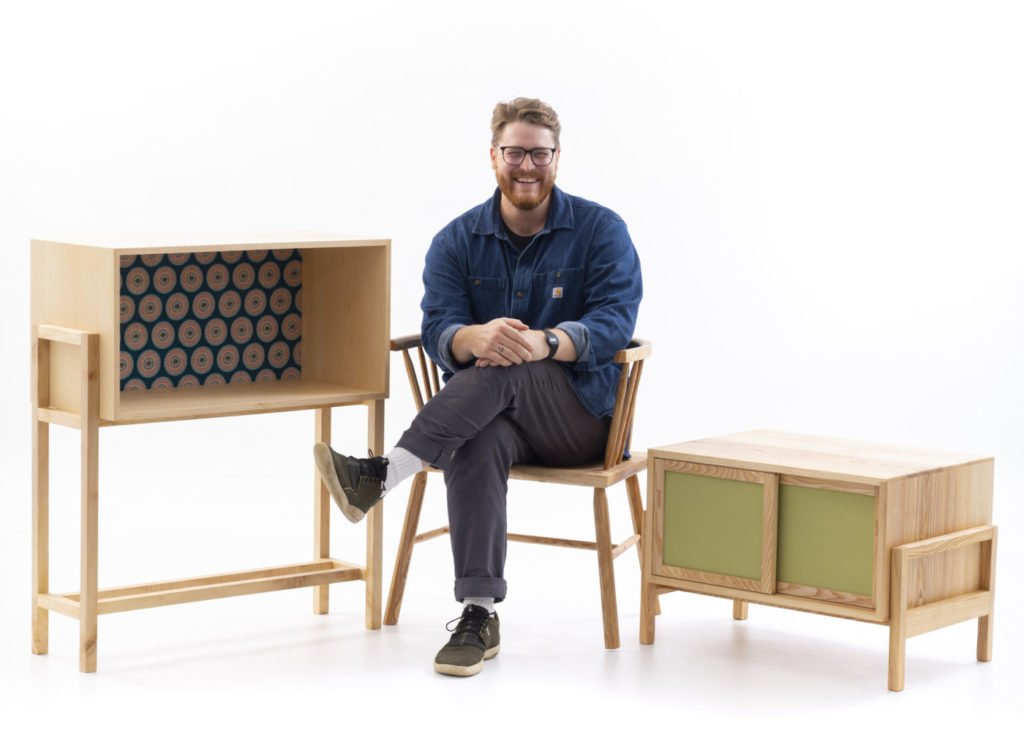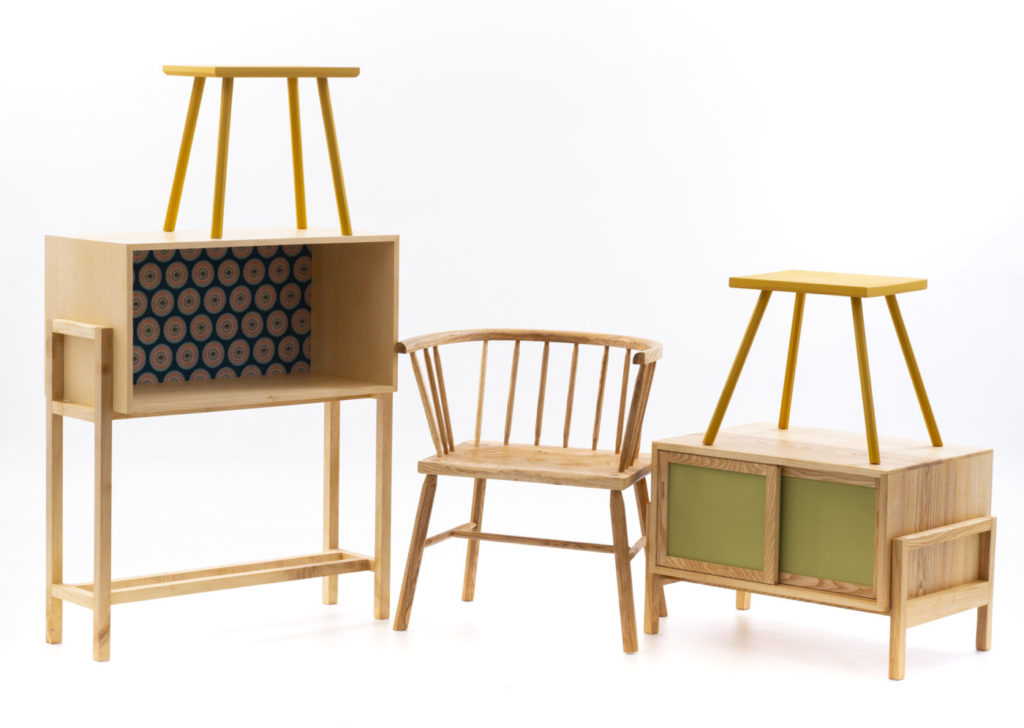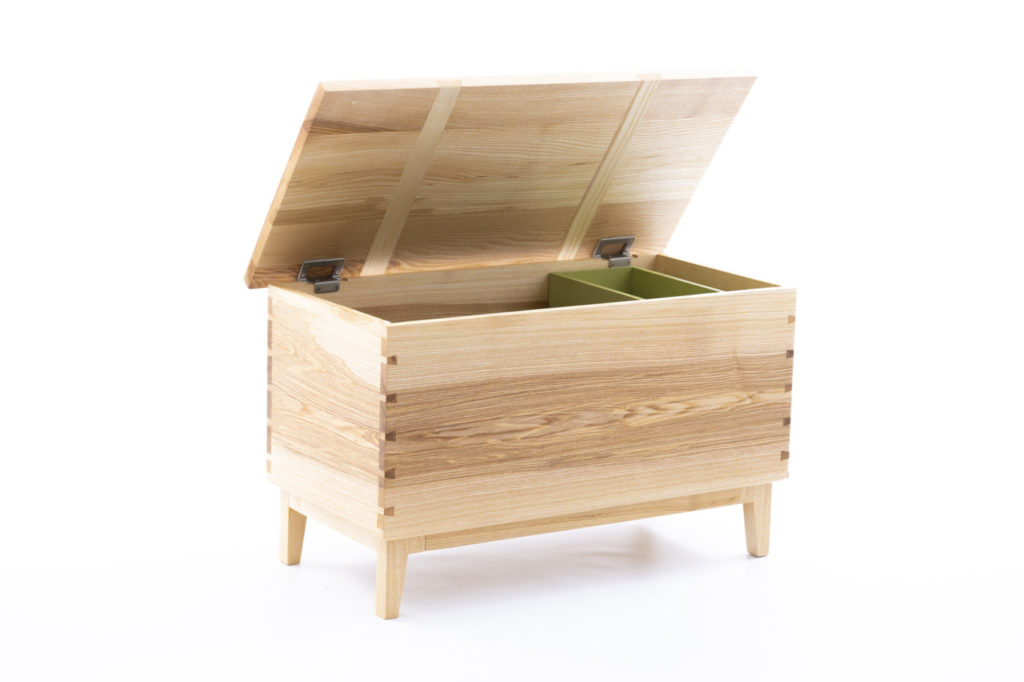We love woodworking start-up stories and Chris Taylor’s tale is truly inspiring. In this blog, we find out how he took the plunge, switched careers, and is carving a career in eco-conscious, vegan furniture making!
What did you do before getting into woodworking? What drew you to pursue it?
Before woodworking I worked as a retail manager at a high-end clothing company. Really what drew me to woodworking was buying our flat. Being based in London, as with other parts of the country, we had to spend everything we had to buy a flat and it needed a lot of work doing to it.
As they say ‘necessity is the mother of invention’, so my partner Emma and I both had to roll up our sleeves and learn new skills from installing a kitchen to tiling a bathroom and making a bed out of some discarded pallets. It was this process that really made me fall in love with making things. Starting the day with a stack of materials and transforming them into something beautiful gives a sense of satisfaction I had not experienced before.
It wasn’t until Emma got a job overseas and we moved to Malawi that I really had the time and inclination to think I could actually make such a drastic career change.
What is the ethos behind Northcote Furniture?
Northcote Furniture is all about making things people like in an eco-conscious way. It is about always challenging myself to come up with techniques and solutions that keep my impact on the planet to a minimum. For me, the great joy of working on bespoke commissions is that you get to interact and work with customers so closely and bring their ideas to life in a beautiful way. You get to solve problems that cannot be addressed any other way and introduce alternative vegan, ethical and more environmentally friendly options in both materials and methods. You also have the opportunity to raise awareness of some of the ways in which they can reduce their environmental impact and empower them to see that they can make considered and sustainable choices.

How did your passion for sustainability start?
Living in Malawi, I was lucky enough to visit some incredible places from Liwonde National Park to watching the sunrise at the top of the rift valley escarpment in Livingstonia. Learning about the changes and impacts of climate change and deforestation in Malawi got me thinking a lot about my impact and where I could make choices that reduce my negative impact on the environment. This led me to make changes in my personal life – including becoming vegan – and inevitably carried over into how I approach my work.
What is your definition of ‘sustainable woodworking’?
Sustainable woodworking starts with sourcing the right materials: from the choice of wood to the choice of hinges. It’s also about making the right objects. Sometimes by making something absolutely to size for a space limits the possible life span of the product. For example, how many CD storage units went to landfill because nothing else would fit in the cubbies once technology moved on? As a designer, pushing yourself to add versatility to a design can do wonders. I often use the phrase ‘sustainability through versatility’. For me, that is about adding lifespan to a product by maximising the number of potential different uses.
What are your customers asking for in terms of design? Do you find they are focused on the sustainability of pieces?
Often you have to lead customers on a journey into thinking about the environmental impact of a piece. Rightly, when many people first approach me they are thinking in terms of form and function. They’re excited to share their vision with me. Also, when you are thinking about a solid wood piece it sounds perfectly sustainable initially as it’s a natural material. But there are so many variables to consider such as the type of tree, the source, country of origin, transport, ethical standards, the list goes on. So, it is about educating customers and sharing your experience and expertise. Explaining the different impact of different finishes for example including the level of VOCs and whether there is a vegan, cruelty-free alternative available. Sometimes it’s as simple as choosing one product over another. However, I think as awareness is growing customers are coming to me with specific ideas concerning sustainability. I have recently started working with several customers that are very interested in having pieces made from reclaimed timber with a desire to reuse materials and avoid using virgin-wood, which presents new challenges and opportunities.

What do you love most about furniture design/woodworking?
I really love the personal satisfaction of working with my hands. As a treat to myself I try and incorporate hand tool work into everything I design. Working with hand tools has a delicate meditative quality to it. My mind quietens and I can float above the day-to-day stresses of life. From a design perspective, I love the problem-solving aspect the most – trying to find an aesthetic solution to a functional problem is often the most challenging and rewarding part of furniture design for me.
In your opinion, what improvements can be made to the sustainability of the woodworking industry? What can individual makers be doing to help?
In the industry we need to think more about what materials we are using, where they come from and what happens to them at the end of the life span. I think for us, the end-of-life impact of our products is particularly important. Choosing to use resins or other plastic goods can change our products from a thing that is biodegradable to a thing that might take over 1000 years to breakdown. For individual makers I think the most important thing is about putting your values at the front of your business. If you believe in trying to live more sustainably, talk to your customers about it, use your experience and expertise to bring them on the journey with you!
I also like to think about how objects become antiques. How can we learn lessons from pieces of the past that have lasted for hundreds of years? Objects become antiques for 3 reasons: firstly, they are built using techniques and materials that are strong enough to withstand the centuries. Secondly, people love them, and the owners care enough to clean them, look after them, and have them repaired if and when they need it. Finally, they are versatile enough to change function over time and in different locations. Whilst our pieces might not become the antiques of the future – we can always dream! – we can definitely learn lessons from the past and apply these same principles to the pieces we make.

What are your top 3 tips for sustainable woodworking?
- Choose the best materials you can and use good quality hardware.
- Think about the end of life, what happens after the product isn’t needed or is broken beyond repair? Consider how you can add future functionality, what happens if the client moves home?
- Decide what your values are and be proud of them and follow through.
What is next for Northcote Furniture?
After graduation I moved back down to the South East where I am working on various residential commissions, setting up a more permanent workspace, and freelancing.
If you would like to learn the skills to start a business like Northcote Furniture, we are currently accepting applications for our next Professional Course for 2022/23. If you are interested in this or any of our other courses, see more information here.
